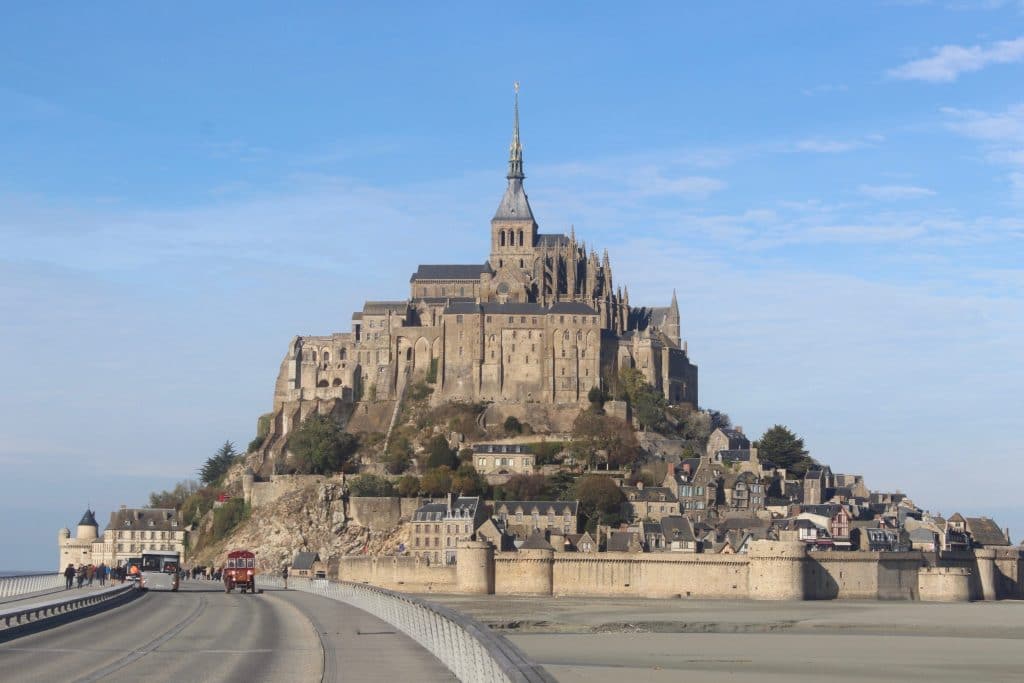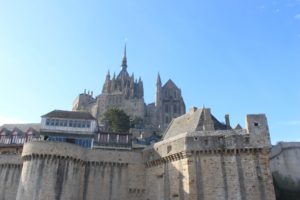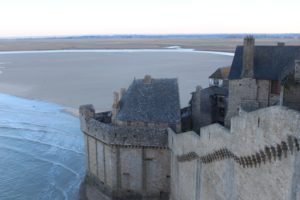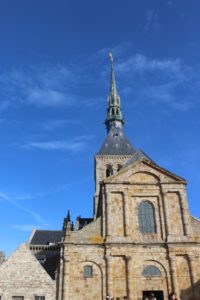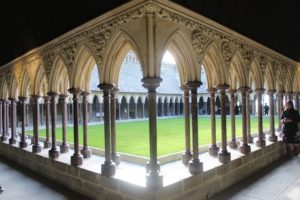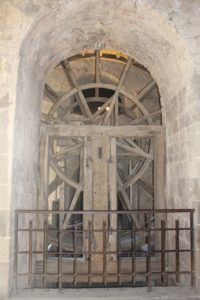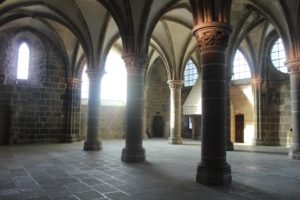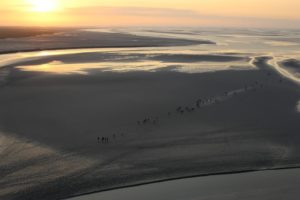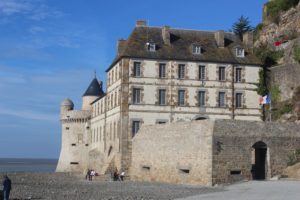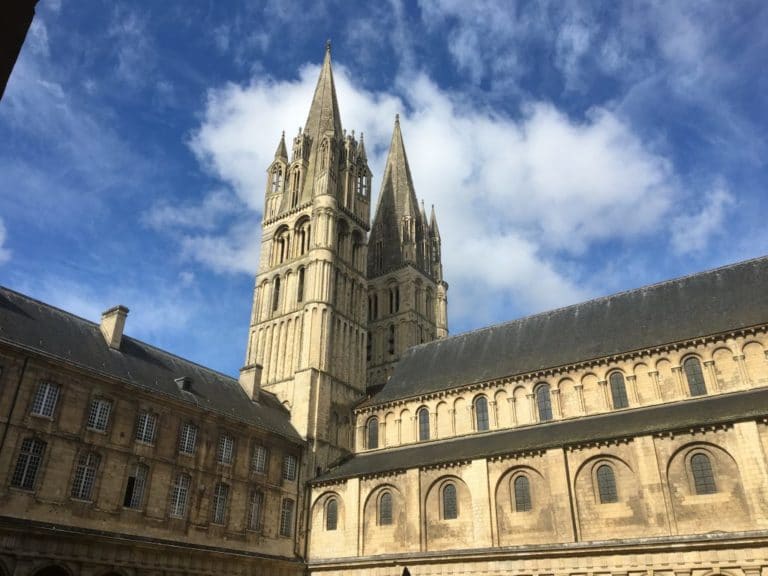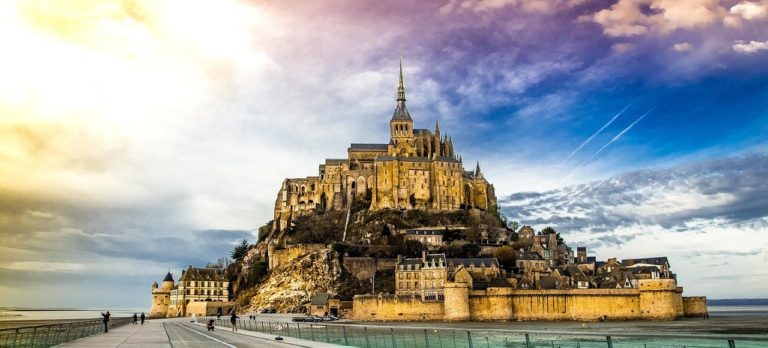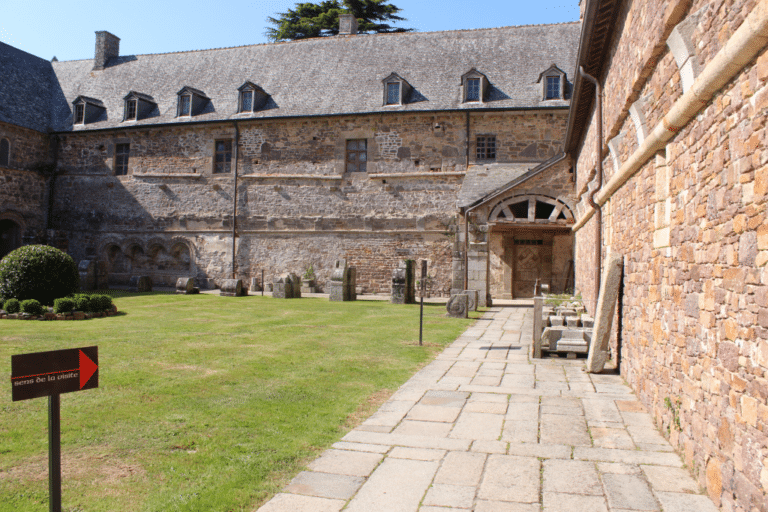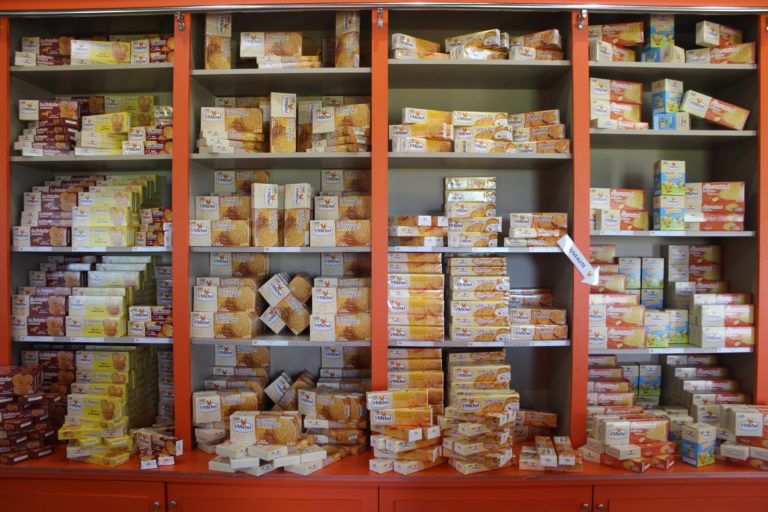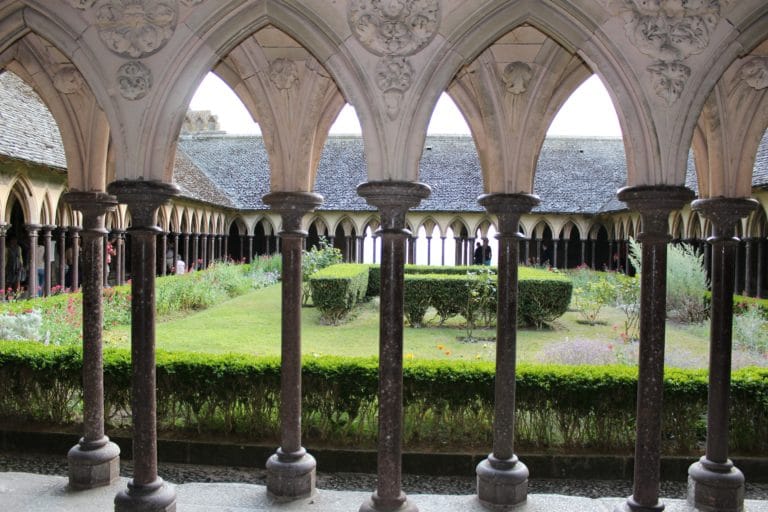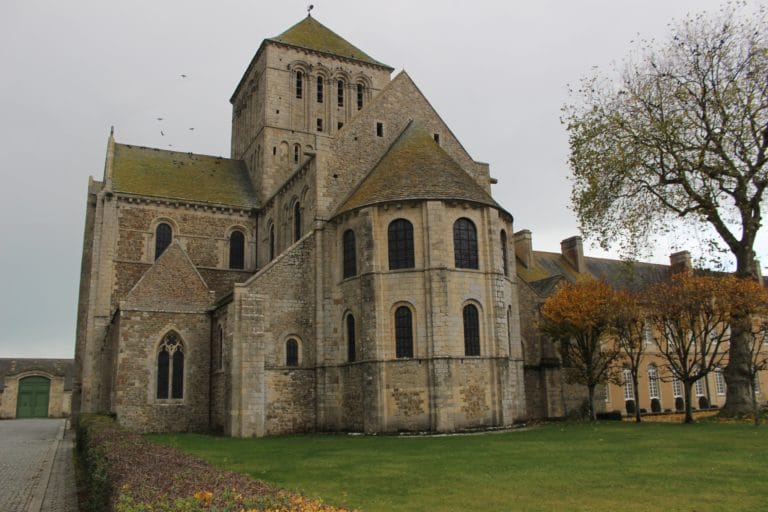A Guide To Mont Saint Michel
A visit to Mont Saint Michel should definitely be on your Normandy bucket list. It’s a rocky island commune topped with a 13th century Gothic abbey. Discover 13 centuries of history and restoration at this UNESCO World Heritage site.
The iconic abbey is perched on top of an island and it literally takes your breath away the first time you see it. It’s magical and an absolute must-see for visitors to Normandy.
If you want an overview of what to expect at Mont Saint Michel then take a look at Rick Steves’ video. This was published in 2009 and shows vehicles parked near to the Mount. This isn’t possible now but check out the ‘Practical Information’ section about parking. In the video you’ll get to see the main street with the shops and restaurants as well as the abbey.
If that’s whetted your appetite, then read on to discover more about the island and its history, the abbey, the dam, things to do in the area, practical information and how to make the most of your visit to Mont-Saint-Michel.
The History of Mont Saint Michel
Mont Saint Michel’s long history began in 708. Bishop Aubert of Avranches erected a sanctuary on the island of Mont Tombe in honour of the Archangel Michel. Benedictine monks settled there in 966 and were responsible for the growth of the new monastery and its focal point for pilgrims.
The Early Years
The diverse architectural styles reflect construction methods dating from the 10th century when it was first built through to the 19th century restoration. The Abbey church is built on the summit of the Mount at an altitude of 80 metres and sits on an 80 metre long platform consisting of four crypts built into the spur of the rock. The abbey church is known as La Merveille; a thirteenth century addition regarded as its crowning glory. The Mount is positioned on the border between Normandy and Brittany and was therefore both a place of passage as well as a fortress for the Duchy of Normandy.
The abbey buildings have been transformed throughout the centuries. The conflicts of the Hundred Years War between France and England in the 14th century led to powerful fortifications being built. These additions included a wall flanked with defensive towers and enabled Mont Saint Michel to resist attacks by English troops. It remains the only place in Normandy not to have been conquered by the English and is a symbol of national identity. In 1421, during a terrifying siege, the Romanesque chancel of the church collapsed, and was not completely rebuilt until 100 years later, in a flamboyant Gothic style.
The 17th Century Onwards
During the 17th and 18th centuries the Mount lost its importance in both military and religious terms. Following the French Revolution the monks of Mont Saint Michel were driven away and the abbey became a prison until it finally closed in 1863. While the prison saved the Abbey from destruction this former religious monument was severely dilapidated. In 1874, the Abbey was classified as a historical monument and the long process of restoration began. A causeway, constructed in 1878, made access to the Mount easier. This was followed by a tramway line for transporting visitors whose numbers continued to grow.
In 1969, a small community of Benedictine monks was established at the Abbey, who were replaced in 2001 by the Monastic Fraternities of Jerusalem.
The conservation work led to it being listed as a UNESCO World Heritage Site in 1979.
The 21st Century
In 2014, a building project started 10 years previously, saw a dam and a new elevated road bridge opened. The previous causeway had permanently linked Mont Saint Michel to the mainland. However, the tidal surges in the bay had led to the area becoming silted up. In July 2014 the new bridge returned Mont Saint Michel to an island. It now becomes cut off from the mainland at very high tides. 2016 saw the statue of Saint Michel being re-gilded.
Today the Archangel shines brightly on top of the world. This project involved shrouding the abbey spire with scaffolding and removing the statue by helicopter before it was replaced. A year long project during 2017 focussed on the restoration of the cloister. The Abbey therefore undergoes continuous building work led by the Chief Architect of Historical Monuments.
The Abbey
A visit to Mont-Saint-Michel isn’t complete without making a visit to the abbey. Only certain parts of it are open to the public and you can follow the signs which take you on a journey across three different levels and through time.
A Tour of The Abbey
The entrance
At the entrance to the abbey, is a stone staircase which will take you to a security point located in the original Guard Room. There may well be a queue of people here belonging to groups and tours. Groups take the left hand side of the staircase and individuals use the right hand side. Once through security (bags will be scanned and you walk through an airport-style scanner to check you have no metal objects on you), head for the ticket office on the right. You can buy an audio guide if required and pick up a leaflet. Retrace your steps to go back to the Guard Room and head over to another stone staircase once your ticket has been checked. You’re now on the lower floor of the building and are going to go up to the upper floor and will by-pass the middle level.
Climbing up to the top
The first part of the tour is outside. Climb up the wide stone stairs of what is known as Le Grand Degré which sits between the abbey buildings and the church. Look up and you’ll see suspended passageways built between the 14th and 16th centuries that linked the two sides. At the top of the stairs are some restrooms (currently the only ones in the abbey) and a small open area giving a great view toward the dam. Go through a small room where there are some models showing the development of the Mount. Walk out into the open and onto the west terrace. If the weather is good, so much the better as you’ll have great views here across the bay. Tombelaine and Mon-Dol are the two smaller islands you can see. Brittany is to your left and the Normandy coastline to your right.
Before you head into the abbey church, take a look at the Neogothic spire of the church tower. It was built in 1897 and has a gilded statue of Saint Michel as it’s crowning glory.
The Church
Now head into the church and explore it before crossing a small room that leads to the cloister. Traditionally cloisters are the centre of an abbey but the Mont-Saint-Michel has buildings on only two sides. One side has three arched windows which give a wonderful view across the bay. The cloister leads directly into the refectory – a vast room with pillars down either side and a wooden vaulted ceiling.
The middle floor
You now leave the upper floor and walk down the stone steps to the middle floor. The first room you visit on this floor is La Salle des Hôtes (Guests’ Hall) which is directly underneath the refectory. This is another huge room which was designed for receiving royalty and nobility. From here, you walk through La Chapelle Saint Madelaine. Leaving here there’s a brief visit into the open air before you walk into a crypt (Crypte des gros piliers). This crypt was built in the mid 15th century and supports the Gothic chancel of the abbey church which is directly above. The large pillars and small windows make the crypt rather dark so head over to the right hand side of the crypt to the exit if you don’t want to linger too long here.
La Grande Roue
A short walk along a passageway leads to another crypt (Saint Martin) that’s is directly underneath the south arm of the abbey church transept. The visit then takes you to the big wheel (La Grande Roue) that occupies the former ossuary where human bones exhumed from churchyards were preserved. The wheel was installed around 1820 and was used to hoist provisions up to the prisoners during the time it was a prison. It replaced pulleys that were used for hoisting building materials up the building during the middle ages. You can see where the pulleys were on the outside of the building slightly towards the left hand side of the building.
The Ambulatory
Another small chapel (Saint Étienne) leads on from here and was the chapel of the dead. As you leave the chapel, you climb another staircase (the north/south stairs) which is directly below the west terrace in front of the abbey church. At the top of the stairs turn right into a covered walkway which the monks used as an ambulatory. At the end of the ambulatory stairs lead down into La Salle des Chevaliers (the Knights’ Hall). This vast room was built to support the cloister which sits directly above it and was where the monks worked and studied.
The ground floor
To leave the middle floor, take the spiral stone staircase which will take you briefly into the other end of the ticket hall on the lower floor. This room is known at the almonry and was where monks received the poor as well as pilgrims. You then walk through into the gift shop and out into the open air. You’re now at the back of the Mount and can get a view of the small chapel at the base of the rock. Walk through the small garden and back out through a turnstile. If you turn right as you come through the turnstile you’ll be heading towards the Abbey entrance. Heading left will take you towards the ramparts and you can now explore the village.
The Island
If you want to explore the small village, it’s completely free to wander around. Watching the spectacle of walkers crossing the bay, glorious sunsets or sunrises as well as the high tides are free. Early morning and evenings tend to be quieter.
Crossing the bay on foot should only be attempted with an experienced guide due to quicksand and a rapidly advancing tide. The Tourist Information Office for Mont Saint Michel can provide you with details of guides.
There are two entrances to the village. The main one is straight ahead of you as you walk along the bridge road.
The Main Entrance
The entrance leads to an entrance where you’ll find the restrooms. Walk through another gate with a drawbridge and you arrive in the narrow cobbled street. This street eventually leads to the foot of the abbey steps. The Tourist Information Office is on the left as you cross the drawbridge. This street (La Grande Rue) is fairly commercial with souvenir shops, bars, restaurants and galleries. However, it’s the only place to buy refreshments on the island and consuming food and drink in the abbey isn’t permitted. There is a small flat grassy area below the abbey where you can pause and take a picnic. At the top of the main street is the parish church of St-Pierre, a cemetery and four museums. Also look up as you navigate the cobbles at the houses above the shops. These houses were built in the 15th and 16th centuries.
If you want a pretty expensive omelette, then perhaps La Mère Poulard restaurant experience is for you. Established in 1888, the house speciality is a fluffy omelette cooked in a copper pan over the fire. You can read the story here.
The Second Entrance
The second entrance is to the left of the main entrance and is a much quieter route away from the shops.
The Dam
The dam is built at the mouth of the Couesnon rives and regulates the ebb and flow of the water. It came into operation in 2009 and offers a great view of Mont Saint Michel. If you catch the free shuttle bus, you can get off at Place du Barrage and explore the dam. It’s the second stop. The bus starts at the tourist Information Centre/car park. The first stop is for a small number of shops, restaurants and cafés. The second is for the dam and the third stop takes you within 350m from the base of the Mount.
More information about the dam is here.
Practical Information
Getting there
Address:
Abbaye du Mont-Saint-Michel
50170 Le Mont-Saint-Michel
Ph. : 33 / (0)2 33 89 80 00
GPS COORDINATES
Latitude : 48.6360
Longitude : -1.5114
BY CAR
From Saint-Malo and the West: Take either the D 155 and D 797 or then N 176 to Pontorson, then D 976. From Caen and the East: Take the A84 and N 175 in the direction of Rennes. At Pontaubault take the D 43, D 75 and D 275 to Le Mont-Saint-Michel. Follow the signs for the parking and ‘navettes’ (shuttle buses). There are two entrances to the car park.
You’ll be directed to a parking area and will take a ticket as you go through the barrier. Take this ticket with you as you’ll need to visit a payment machine just prior to returning to your car. For information about parking costs, click here.
You now have three options to get to the island – on foot (30 – 45 minutes), a free shuttle bus called Le Passeur (12 minutes) or a horse drawn carriage which is a paid service. For more information click here.
BY TRAIN/BUS
A special bus route runs from Pontorson train station to the island with journeys scheduled to connect with the train timetable. For more information see this page.
The Tourist Information Centre
The centre is near the car park and is open 10am – 6pm every day except 1 January and 25 December. There’s an exhibition about the island, restrooms, baby changing facilities, car park ticket machines and kennels. Animals (other than guide dogs or assistance animals) are not permitted on the shuttle bus. You can take your pet to the island by walking there although they are not allowed in the abbey. There’s also a TIC on the island and you can click on the link for more information.
Opening Hours For The Abbey
Check the Mont Saint Michel abbey website for up to date information. The abbey is closed: 1 January, 1 May and 25 December. In the last few years, visitors have been able to enjoy extended evening opening hours which have been very popular.
Prices For Entry To The Abbey
Information about prices can be found on the abbey website.
Entry to the abbey is free of charge on the first Sunday of the month, between November and March. Audio guides are an additional 3€.
There are scheduled guided tours throughout the year in French and English. There are usually two a day – one in the morning and one in the afternoon. You don’t need to book and there’s no additional charge on top of your admission fee. They last around an hour and a quarter. Ask at the ticket desk for information. There are additional tours and talks in French. You could also organise your own tour of the abbey and or the village with an English speaking guide, pick up the English version of the short leaflet in the ticket hall or buy an audioguide.
The surrounding area
The Mont Saint Michel website has details of what to do in the surrounding area including helicopter trips, train rides around the bay, American and German cemeteries, artisan producers, health and well-being experiences and nature trails. You can also explore towns and villages in nearby Brittany.
How can you make the most of your time there?
During the summer Mont Saint Michel is busy but given it’s an UNESCO World Heritage site, it’s not surprising. The information above will give you some of the practical information on tide times, parking, the shuttle buses etc. I’d recommended going early or late in the day to avoid the crowds. Between 12 and 2pm is also a good time as many people will be lunching. Saturday can also be a good time as this is often the start and end day for holidays in peak season. The summer evening openings are also a little quieter.
The main entrance is to the left of the red and yellow Normandy flag.If the tide is low enough, head for the building on the far left instead. This is a quieter route and gives you a great view of those fascinating turrets you can see. It’s often busy around the steps leading up to the abbey but there are two queues and one is for groups. You should take the queue on the right hand side which is for individuals. Once you’ve got your tickets, take a free leaflet and decide if you want to purchase an audio guide. Then, you can wander round to your hearts content admiring the amazing architecture and views across the bay. Take your time as it’s not easy to double back as in places you go down narrow spiral stone staircases.
To help you plan your time at Mont-Saint-Michel, the following websites may be useful.
The French website.
The English version of the website is here.
This leaflet is also very useful as it includes information about the dam, the Tourist Information Centre, a map of the car park and ways to get to the island.
You can find information and a leaflet about the damn here.
Useful Tips
- There are a lot of steps on the island and in the abbey
- Taking a pushchair isn’t recommended due to the steps and cobbled streets
- Check the tide times and opening times of the abbey
- Take your time in the abbey as doubling back isn’t easy
- Restrooms are located at the Tourist Information Office, inside the main entrance to the island, at the top of La Grande Rue and at the top of the first staircase in the abbey
- Refreshments can be purchased before you get to the island is the shops near the car park or in the bars and restaurants on the island.
- Food and drink shouldn’t be consumed in the abbey
- Dogs aren’t allowed on the shuttle bus or in the abbey. They are permitted to go on the island and possibly in bars and restaurants depending on their policy.
- Some ticket machines for the car park only take cash and others only take credit card
- Take your car parking ticket with you and pay for it before you return to your vehicle.
- Parking ticket machines are near the Tourist Information Centre and the main walkways to the car parks.
